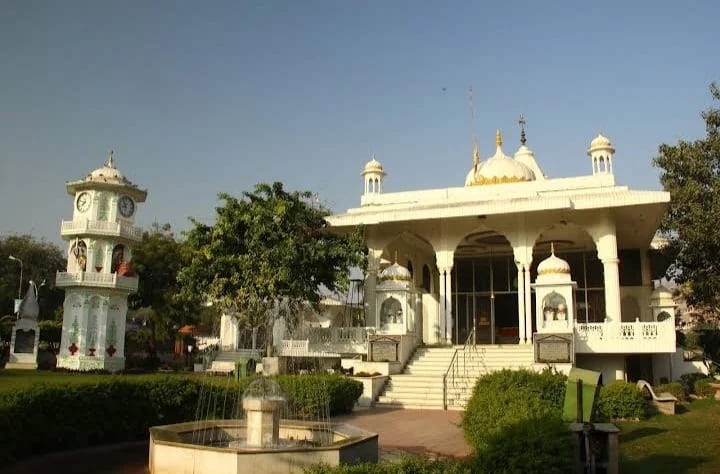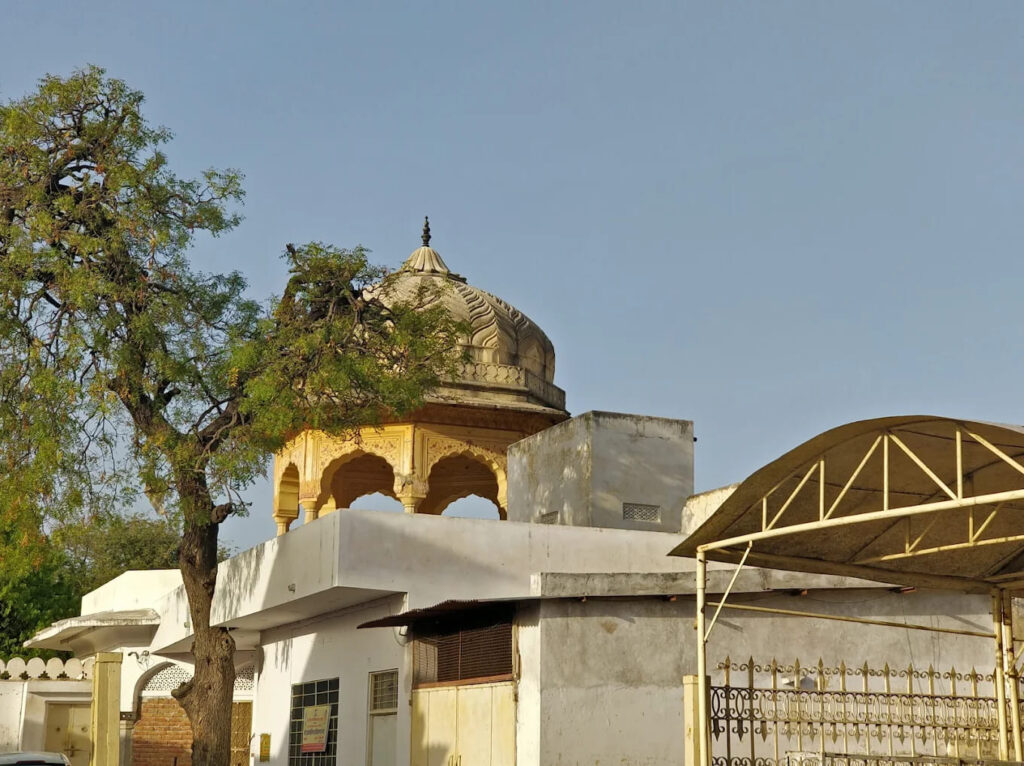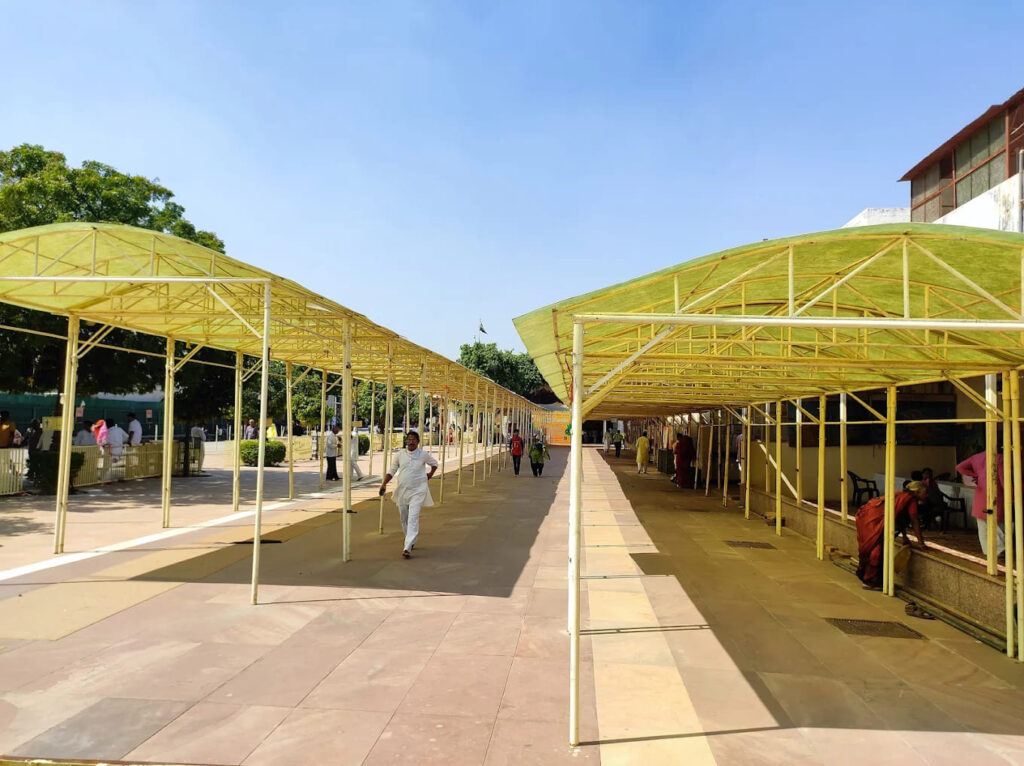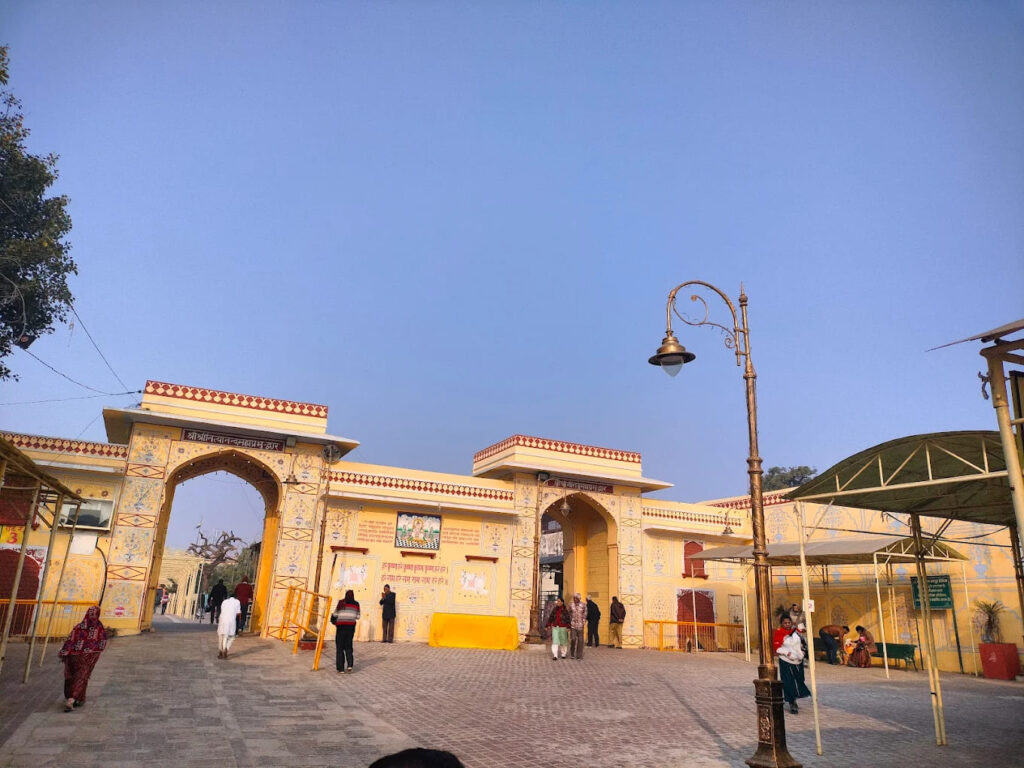Nestled within the majestic City Palace complex of Jaipur, the Govind Dev Ji Temple is one of the most revered shrines dedicated to Lord Krishna, worshipped here in the form of Govind Dev Ji. Considered the divine manifestation of Krishna during his incarnation on earth, the temple holds immense spiritual significance for devotees across Rajasthan and India.

The temple is not just a place of worship but also a living symbol of Jaipur’s cultural heritage. Every day, thousands of devotees gather here to attend the darshan and witness the enchanting aarti rituals. The rhythmic chants, devotional bhajans, and vibrant atmosphere make this temple a soul-stirring experience for pilgrims and tourists alike.
Unlike many temples, Govind Dev Ji Temple is renowned for its unique practice of offering seven daily darshans, allowing devotees to see the deity in different forms and moods throughout the day. This ritual makes it one of the busiest and spiritually rich temples in Rajasthan.
For anyone visiting Jaipur, the Govind Dev Ji Mandir is not just a religious stop but a must-visit cultural landmark that beautifully blends devotion, history, and tradition.
Also Check: Famous Temples of Jaipur
History of Govind Dev Ji Temple
The Govind Dev Ji Temple in Jaipur has a history deeply rooted in devotion and royal patronage. The deity worshipped here is believed to be one of the seven sacred idols of Lord Krishna crafted by Vajranabh, the great-grandson of Lord Krishna himself. According to legend, these idols were created to preserve Krishna’s divine form for generations to come.
Originally, the idol of Shree Govind Dev Ji was enshrined in Vrindavan, the land closely associated with Lord Krishna’s pastimes. During the Mughal era, to protect it from possible harm, the idol was moved from Vrindavan and brought to Jaipur in the 18th century.

The installation of the idol in Jaipur was done under the reign of Maharaja Sawai Jai Singh II, the founder of Jaipur. It is said that Jai Singh II, a devout follower of Lord Krishna, dreamt of the deity and was instructed to establish the idol in his palace complex. To honor this divine vision, he constructed the Govind Dev Ji Temple inside the City Palace gardens, ensuring that the royal family and the people of Jaipur could worship the deity.
Since then, the temple has remained a central place of worship for Krishna devotees. Over the centuries, the temple has also become an integral part of Jaipur’s religious and cultural life, hosting grand celebrations of Janmashtami, Holi, and Radhashtami.
The strong historical connection between Vrindavan and Jaipur makes the Govind Dev Ji Temple unique, as it is believed that the idol here most closely resembles Krishna’s actual earthly form.
Also Check: Akshardham Temple Jaipur
Architecture of Govind Dev Ji Temple
he architecture of Govind Dev Ji Temple is a striking example of Jaipur’s heritage, showcasing a blend of Rajasthani, Mughal, and traditional Hindu temple design. Built under the guidance of Maharaja Sawai Jai Singh II, the temple reflects both simplicity and grandeur, ensuring accessibility for large gatherings of devotees.
Temple Layout
The shrine is constructed within the City Palace complex, surrounded by spacious courtyards and beautifully landscaped gardens. The temple hall is designed in such a way that it can accommodate thousands of devotees during the darshan and aarti rituals. Unlike many temples, the deity here is placed at an accessible height, allowing worshippers to have a clear and close view of Lord Govind Dev Ji without any obstruction.
Architectural Features
- The temple is built with red sandstone and marble, materials that were commonly used in Jaipur’s historic monuments.
- Large arched windows and open courtyards bring in natural light, giving the temple an aura of peace and positivity.
- The sanctum sanctorum (Garbhagriha) houses the sacred idol of Lord Govind Dev Ji, decorated with vibrant clothes and ornaments that change several times a day as per the darshan schedule.
- Intricate carvings, frescoes, and traditional motifs adorn the walls and ceilings, depicting stories from Krishna’s life and the Bhagavata Purana.
Spiritual Design
Unlike heavily ornamented temples, the design here focuses on devotee–deity connection. The open layout ensures that every devotee, whether standing at the back or front, can clearly see the idol. This accessibility is one of the reasons why the temple attracts such a massive daily footfall.
The harmonious blend of art, devotion, and functionality makes the Govind Dev Ji Temple’s architecture not just visually appealing but also spiritually fulfilling.


Darshan Timings & Aarti Schedule
One of the most unique features of the Govind Dev Ji Temple Jaipur is its seven daily darshans. Devotees believe that each darshan reveals Lord Krishna (Govind Dev Ji) in a different mood, attire, and form, representing various moments of his earthly life in Vrindavan.
Daily Darshan Schedule
The temple opens early in the morning and closes late in the evening, with seven darshan sessions spread throughout the day.
| Darshan / Aarti | Timing (Approx.) | Significance |
|---|---|---|
| Mangla Aarti | 4:30 am – 5:00 am | Early morning darshan when the deity is awakened. |
| Dhoop Darshan | 7:45 am – 9:30 am | Deity adorned in morning attire with fragrance of incense. |
| Shringar Darshan | 9:30 am – 10:45 am | Lord dressed with ornaments and flowers. |
| Rajbhog Darshan | 11:00 am – 12:15 pm | Offering of the main meal (Rajbhog) to the deity. |
| Gwal Darshan | 5:30 pm – 6:00 pm | Evening darshan when the deity is prepared as a cowherd. |
| Sandhya Aarti | 6:30 pm – 8:00 pm | Sunset darshan with devotional bhajans and lamps. |
| Shayan Aarti | 9:00 pm – 9:30 pm | Final darshan of the day before the deity rests. |
Special Darshan on Festivals
On occasions like Janmashtami, Holi, Radhashtami, and Diwali, the temple extends its darshan hours, and the deity is adorned with special decorations and ornaments. Thousands of devotees line up for darshan on these days, making the temple vibrant with devotion, music, and festivity.
Unique Devotee Experience
Unlike many temples in India where darshan may be restricted or brief, here devotees enjoy a clear, unobstructed view of the deity from anywhere in the prayer hall. This accessibility adds to the temple’s immense popularity, with devotees attending multiple darshans throughout the day.
Festivals at Govind Dev Ji Temple
The Govind Dev Ji Temple in Jaipur is not just a daily place of worship but also a grand center of celebration during festivals. Throughout the year, the temple comes alive with vibrant decorations, devotional music, and large gatherings of devotees. These festivals highlight the deep bond between Lord Krishna and his devotees, making the temple a cultural and spiritual hotspot.
Major Festivals Celebrated
1. Janmashtami (Krishna Janmotsav)
- The biggest and most significant festival at the temple.
- Celebrates the birth of Lord Krishna with midnight darshan, bhajans, dance-drama performances, and colorful decorations.
- Thousands of devotees from Jaipur and nearby regions gather, making it a spectacular event.
2. Holi (Festival of Colors)
- The temple is decorated with flowers and natural colors.
- Devotees sing Rasiya songs and play Holi in traditional style with gulal and flower petals.
- Holi at Govind Dev Ji Mandir is world-famous for its devotional and cultural charm.
3. Radhashtami
- Celebrated as the appearance day of Radha Rani, consort of Lord Krishna.
- The idol of Radha is adorned with special ornaments and flowers.
- Devotees sing bhajans praising Radha-Krishna’s eternal love.
4. Diwali & Annakoot
- On Diwali, the temple is illuminated with thousands of lamps.
- The following day, Annakoot is celebrated, where a huge variety of food items (bhog) are offered to the deity, symbolizing abundance and gratitude.
5. Kartik Purnima & Other Vaishnav Festivals
- Special darshan, kirtans, and processions are held.
- The temple also observes Govardhan Puja and Gopashtami with enthusiasm.
The Festival Atmosphere
During these occasions, the temple transforms into a devotional carnival – bhajan singing, chanting of mantras, playing of musical instruments, and vibrant traditional attire make the atmosphere divine. For devotees, participating in these festivals is considered a sacred blessing.
Location & How to Reach Govind Dev Ji Temple
The Govind Dev Ji Temple is conveniently located in the heart of Jaipur, inside the City Palace complex. Its central location makes it easily accessible for both locals and tourists who come to seek blessings or explore Jaipur’s heritage.
Temple Address
Govind Dev Ji Temple, City Palace Complex, Jaleb Chowk, Jaipur, Rajasthan – 302002
Google Map Location: https://maps.app.goo.gl/C22FkHcJY6K3qvXv7
How to Reach
By Air
- The nearest airport is Jaipur International Airport (JAI), located around 11–12 km from the temple.
- From the airport, taxis, cabs, and app-based rides (Ola, Uber) are easily available.
By Train
- The closest railway station is Jaipur Junction, just 5 km away.
- Auto-rickshaws and prepaid taxis are the most convenient ways to reach the temple from the station.
By Road
- Jaipur is well-connected by national highways.
- The temple lies about 4 km from Sindhi Camp Bus Stand, the main intercity bus terminal.
- Local buses, e-rickshaws, and shared autos frequently operate in this area.
Local Transport Options
- Auto-rickshaws & E-rickshaws: Common and affordable for short distances.
- Cycle Rickshaws: A more traditional way to travel through the old city lanes.
- Taxis & Cabs: Available via Ola, Uber, or local taxi operators.
Nearby Landmarks
Since the temple is inside the City Palace complex, visitors can also plan a trip to:
- City Palace Jaipur (within the same complex)
- Jantar Mantar (approx. 500 m)
- Hawa Mahal (approx. 1 km)
- Jal Mahal (approx. 5 km)
Best Time to Visit Govind Dev Ji Temple
The Govind Dev Ji Temple in Jaipur is open to devotees throughout the year, but the experience can be very different depending on the season, time of day, and festive occasions. Planning your visit wisely ensures a more comfortable and spiritually fulfilling darshan.
Seasonal Recommendations
- October to March (Winter & Spring)
- This is the best time to visit Jaipur, with pleasant weather ideal for temple visits and sightseeing.
- Major festivals like Diwali, Annakoot, and Holi also fall during this period, making the temple atmosphere even more vibrant.
- April to June (Summer)
- Jaipur experiences extreme heat during summer.
- If visiting in this season, attend the early morning Mangla Aarti (around 4:30 am) or evening Sandhya Aarti when temperatures are cooler.
- July to September (Monsoon)
- The city becomes greener and less crowded.
- This period is good for those who prefer a quieter temple visit, though occasional rains may affect travel.
Daily Timings to Choose From
- Morning Darshan: Early darshans like Mangla Aarti and Shringar Darshan are considered highly auspicious and spiritually uplifting.
- Evening Darshan: Sandhya Aarti at sunset is one of the most enchanting experiences at the temple
Best Occasions to Visit
- Janmashtami: Witness grand midnight celebrations of Lord Krishna’s birth.
- Holi: Famous for its devotional style of playing colors with flower petals.
- Radhashtami & Govardhan Puja: Spiritual festivals deeply connected with Krishna’s leelas.
Nearby Attractions Around Govind Dev Ji Temple
Located inside the City Palace complex, the Govind Dev Ji Temple is surrounded by some of Jaipur’s most iconic landmarks. Visitors can easily combine a temple darshan with sightseeing to experience the city’s cultural richness.
1. City Palace Jaipur
- The temple itself lies within the City Palace premises.
- Built by Maharaja Sawai Jai Singh II, the palace is a blend of Rajput, Mughal, and European architecture.
- Must-see areas: Mubarak Mahal, Chandra Mahal, and Maharani’s Palace Museum.
2. Jantar Mantar (UNESCO World Heritage Site)
- Just 500 meters away from the temple.
- An astronomical observatory built in the 18th century, showcasing giant instruments used to study celestial bodies.
- A must-visit for history and science enthusiasts.
3. Hawa Mahal (Palace of Winds)
- Located about 1 km from the temple.
- Known for its 953 intricately carved windows (jharokhas).
- Built for royal women to observe street festivals without being seen.
4. Jal Mahal (Water Palace)
- About 5 km from Govind Dev Ji Temple.
- A palace situated in the middle of Man Sagar Lake, known for its scenic beauty.
- Best visited during early morning or sunset for photography.
5. Albert Hall Museum
- Located around 3 km away, near Ram Niwas Garden.
- The oldest museum of Rajasthan, famous for Indo-Saracenic architecture and rare artifacts, including Egyptian mummies.
6. Local Bazaars of Jaipur
- Johari Bazaar & Bapu Bazaar are within 2–3 km.
- Perfect spots for shopping jewelry, textiles, handicrafts, and souvenirs after your temple visit.
Why Explore Nearby Attractions?
Visiting Govind Dev Ji Temple offers not just a spiritual experience but also an opportunity to explore Jaipur’s heritage, culture, and architecture in close proximity. Combining these attractions makes for a fulfilling half-day or full-day itinerary in the Pink City.
Visitor Tips & Guidelines for Govind Dev Ji Temple
A visit to the Govind Dev Ji Temple in Jaipur is both a spiritual and cultural experience. To ensure a smooth darshan and respectful temple visit, here are some useful tips and guidelines:
1. Dress Code & Attire
- Wear modest and traditional clothing when visiting the temple.
- Light cotton clothes are best in summer, while shawls or sweaters may be needed in winter mornings.
- Avoid flashy or revealing attire out of respect for the sacred environment.
2. Best Time to Visit
- Early mornings (Mangla Aarti) and evenings (Sandhya Aarti) offer the most divine atmosphere.
- Weekdays are less crowded compared to weekends and festivals.
3. Offerings & Prasad
- Devotees can bring flowers, sweets, and fruits as offerings.
- Prasad is available inside and outside the temple from vendors.
- Avoid bringing plastic bags; eco-friendly packets are encouraged.
4. Photography & Mobile Usage
- Photography is usually not allowed inside the sanctum sanctorum.
- Mobiles should be kept on silent mode.
- Respect temple rules and signs posted for visitors.
5. Crowd Management
- The temple attracts thousands of devotees daily.
- For a peaceful experience, plan your visit during early hours.
- During festivals like Janmashtami and Holi, expect long queues and heavy rush.
6. Accessibility & Facilities
- The temple premises are wheelchair-friendly with wide courtyards.
- Drinking water and basic washroom facilities are available nearby.
- Shoe stands are provided outside the temple.
7. General Etiquette
- Maintain silence and avoid pushing in queues.
- Sit for a while during bhajans to soak in the devotional energy.
- Always respect the traditions and rituals of the temple.
FAQs About Govind Dev Ji Temple Jaipur
What are the darshan timings of Govind Dev Ji Temple?
The temple offers seven darshans daily, starting with Mangla Aarti at around 4:30 am and ending with Shayan Aarti around 9:00 pm. Exact timings may vary slightly on festivals and special days.
Where is Govind Dev Ji Temple located?
It is situated inside the City Palace complex, Jaleb Chowk, Jaipur, Rajasthan, making it easily accessible from all parts of the city.
Which deity is worshipped in Govind Dev Ji Temple?
The temple is dedicated to Lord Krishna, worshipped here in the form of Govind Dev Ji, believed to be one of the seven idols crafted by Vajranabh, Krishna’s great-grandson.
What is the best time to visit Govind Dev Ji Temple?
The best time to visit is during early morning (Mangla Aarti) or evening (Sandhya Aarti). Season-wise, October to March is most pleasant for travelers.
Can I watch Govind Dev Ji Temple darshan online?
Yes, the temple often provides live darshan streaming during major festivals like Janmashtami and Holi. Many devotees also follow updates through official temple websites and social platforms.
Which festivals are celebrated at Govind Dev Ji Temple?
The biggest celebrations include Janmashtami, Holi, Radhashtami, Diwali, Annakoot, and Govardhan Puja, when thousands of devotees gather for grand festivities.
How far is Govind Dev Ji Temple from Jaipur Railway Station?
The temple is approximately 5 km from Jaipur Junction Railway Station, easily reachable by auto-rickshaw, cab, or local bus.
Why is Govind Dev Ji Temple so famous?
The temple is unique because devotees get a clear and unobstructed view of the deity from anywhere in the hall. Its rich history, daily darshan schedule, and festive grandeur make it one of the most visited Krishna temples in India.
